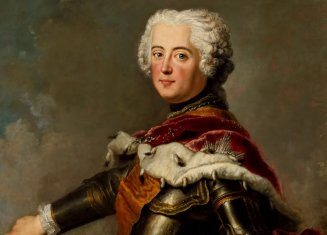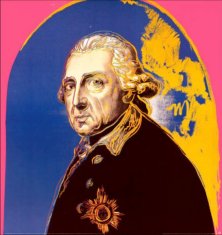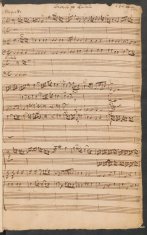|
|
Christoph Nichelmann (Composer, Keyboard, Copyist, Bach's Pupil) |
|
Born: August 13, 1717 - Treuenbrietzen, Brandenburg, Germany
Died: July 20, 1762 - Berlin, Germany |
|
Christoph Nichelmann was a German composer and keyboard player at the court of King Frederick the Great. His father was Christoph Nichelmann (cloth maker in Treuenbrietzen). After studying music in his native town, he He enrolled at the Thomasschule in Leipzig on October 6, 1730; and studied there from 1730 to 1733 (early escape from the school together with Johann Gottfried Böhme (B-21)); also private studies with J.S. Bach; he had an admirable treble voice (according to the booklet that accompanies the J.E. Gardiner's recording "The first performance of Cantata BWV 51 was produced on September 17, 1730, with the virtuosic solo part sung by a 12-year-old boy, Christoph Nichelmann"), sometimes assisted J.S. Bach in copying out parts in 1730-1733 (the Motet Komm, Jesu, Komm!, BWV 229 is known from a score copied by Nichelmann; he also made copies of Cantatas BWV 42, BWV 180). He is identified in J.S. Bach's manuscripts as Anon. 400; J. S. Bach XXXI; J. S. Bach XXXII. He studied the keyboard and composition with Wilhelm Friedemann Bach, but left for Hamburg in 1733, where he stayed until 1738 to pursue his interest in opera (meanwhile one year as a piano teacher on an estate near Oldenburg). There he studied the French and Italian styles as well as general theatrical technique with the leading musical figures, Reinhard Keiser, Georg Philipp Telemann and Johann Mattheson.
For several years Christoph Nichelmann alternated periods of study with periods of employment as private musician and secretary to various noble families. From 1739 to 1745 he stayed mainly in Berlin to pursue a musical career. Since the accession of Frederick the Great, Berlin had become an active musical centre which attracted some of the best-known musicians of the time, and Nichelmann continued his study with Johann Joachim Quantz, the king's flute instructor, and with the Kapellmeister Carl Heinrich Graun. His first printed keyboard sonatas were completed during this period; and from 17444 or 17453 to 1755 he was chamber musician in the royal court chapel in Berlin, joining Carl Philipp Emanuel Bach as one of two harpsichordists in the royal establishment. From 1755 he had freelance (teaching) activity in Berlin.
In keeping with the general tenor of literary activity in Berlin, and in response to the controversy over the merits of the French and Italian styles, Christoph Nichelmann brought out in 1755 an extended treatise which attracted much attention, Die Melodie, nach ihrem Wesen sowohl, als nach ihren Eigenschaften. The work is unusual in that it focusses throughout on melody, yet much of the substance derives from the earlier writings of J.-P. Rameau. A pseudonymous Caspar Dünkelfeind severely criticized it in Gedanken eines Liebhabers der Tonkunst (Nordhausen, 1755), and Nichelmann continued the discussion in Die Vortrefflichkeit der Gedanken des Herrn Caspar Dünkelfeindes über die Abhandlung von der Melodie. Nichelmann’s departure from court in 1756 has been attributed to this literary exchange, but Friedrich Wilhelm Marpurg wrote that he requested and was granted his release from the king’s service. Nichelmann wrote most of his smaller keyboard pieces and songs during his remaining years in Berlin, years made difficult by the upheavals of the Seven Years War.
The earliest date on any Christoph Nichelmann manuscript is 1737, the latest 1759, outlining a period when musical styles were changing rapidly and one in which Berlin emerged as an important musical centre. The relative significance of the Berlin school derives from several factors, including the literature on music originating there and the continued development of the keyboard concerto following its inception by J.S. Bach. Nichelmann participated in both activities, but his main contribution lay in the realm of the keyboard concerto, which was still a relatively new genre at the time, one which reflected many of the changes in musical style which have come to be associated with the Enlightenment. His works in this medium present the keyboard as a solo instrument with an established technique capable of a wide variety of musical effects. The emphasis on phrase structure and slower harmonic rhythm, the idiomatic conception for the solo instrument and the trend towards a condensed reprise of materials are features of Nichelmann’s concertos which became basic to much instrumental music later in the 18th century. The sonatas and miscellaneous keyboard pieces have appeared in many editions and are the works by which he is best known. Although probably conceived for dilettantes (see the title to his first published sonatas), the sonatas require a well-developed technique and their keyboard writing is thoroughly idiomatic. They are in three movements (fast–slow–fast), using binary dance structure, with the outer movements carrying most weight. The miscellaneous pieces are miniatures intended for a society which valued such pieces; among them are works of genuine vitality.
Among the vocal works, the serenata Il sogno di Scipione enjoyed some popularity in the 18th century; only the opening sinfonia has appeared in a modern edition. A cantata and a requiem stand as isolated examples in Christoph Nichelmann’s catalogue, and his 22 lieder should be noted as early examples of the genre.
In 1754/1755 Friedrich Wilhelm Marpurg named Christoph Nichelmann's J.S. Bach "in den öffentlichen Stunden" (in the public hours) of the Thomasschule and Wilhelm Friedemann Bach in the keyboard playing; in addition, he had "unter der Aufsicht seiner vortreflichen Lehrmeister, einige Versuche in der Composition" (made a few attempts in the composition under the supervision of his excellent teachers). These statements do not seem to indicate systematic private lessons with J.S. Bach. Nichelmann's knowledge of the French suites documented in 1755 could, of course, still be traced back to his piano lessons (with J.S. Bach. or W.F. Bach). In addition to W.F. Bach, C.P.E. Bach (perhaps only in Berlin) claims to have taught C. Nichelmann.
References: Richter: 125; Koska: B-20; GND: 119317133; Bach Digital: 00003873 |
|
Writings |
|
Die Melodie, nach ihrem Wesen sowohl, als nach ihren Eigenschaften (Danzig, 1755)
Die Vortrefflichkeit der Gedanken des Herrn Caspar Dünkelfeindes über die Abhandlung von der Melodie (c1756) |
|
Works |
|
For complete list of thematic incipits and correlation of MSS and published works, see Lee (Detroit, 1971) and Krebs (2002)
Instrumental:
18 concertos., harpsichord, strings, 1740-1759, A-Wgm, B-Bc, D-Bsb, Dl, ROu, GB-Ckc, US-BEm; 2, A, E, ed. D. Lee (Madison, WI, 1974)
Concerto, violin, strings, D-Bsb
3 Ouvertures, B-flat, 2 oboe, 2 violin, viola b; G, 2 horn, 2 flute, 2 oboe, 2 violin, viola, b; D, 2 horn, 2 violin, viola, b, all in D-Bsb
2 sinfonias, F, G, strings, GB-Lbl
Sinfonia, E-flat, 2 flute, 2 horn, 2 oboe, strings; orig. ov., Il sogno di Scipione, score D-ROu
Sinfonia, E, 2 horn, 2 flute, 2 oboe, 2 violin, viola, b (score fragment), D-Bsb
2 Sonatas, G and C, flute, cemb. obbligato, 2 pb, D-Bsb
Sonata, b, 2 flute, bc, score, D-Bsb, S-L
2 trios: e, 2 flute, bc, pb; F, 2 flute, bc, score, both D-Bsb
Solfeggio for flute, DK-Kk
Keyboard:
6 brevi sonate da cembalo massime all’uso delle dame (Nuremberg, 1745/R Geneva, 1986)
[6] Brevi sonate da cembalo all’ uso di chi ama il cembalo, op.2 (Nuremberg, c1745/R Geneva, 1986); repubd as Six Short Sonatas or Lessons, hpd (London, c1770)
Sonata, a, hpd, in Tonstücke für das Clavier (Berlin, 1774)
6 additional hpd sonatas in autograph MSS: 4 in VI sonate, D-Bsb; 1, A, F-Pn; 1, G, D-ROu
2 Allegros, E, hpd, in Raccolta delle più nuove composizioni di clavicembalo (Leipzig, 1756)
Rondo, G, in Kleine Clavierstücke nebst einigen Oden von verschiedenen Tonkünstlern (Berlin, 1760)
4 pieces in Musikalisches Allerley, i–vi (Berlin, 1761–3): La gaillarde, La tendre, i; Claviersuite, v; Allegro in E-flat, vi
Allegretto in E-flat, Allegro in G, Presto in e, in Clavierstücke mit einem practischen Unterricht (Berlin, 1762)
6 menuets, 6 polonaises, Variations, D-Bsb
Vocal:
La Galatea (P. Metastasio), 1740
Il sogno di Scipione, serenata (Metastasio), Berlin, 1746, D-ROu; Sinfonia, ed. M. Schneider (Leipzig, 1957)
Requiem, 4vv, 2 flute, 2 oboe, 2 violin, viola, b, D-Bsb
Zeffirretti, cant., S, 2 violin, viola, b, US-Wc
Il fiume spre, aria in Il rè pastore (remainder by Frederick II, J.J. Quantz, C.H. Graun), D-Bsb
22 Lieder, 1v, kbd, in contemporary collections: see Lee (Detroit, 1971) |
|
Works of Bach he copied [Manuscript No. in Bach Digital / Work / Performance date] |
|
D-B Am.B 32: BWV 42 [1732/1733]
D-B Am.B 36: BWV 91, early version [1732/1733]
D-B Am.B 102-104, Faszikel 3: BWV 64 [probably 1730/1731]
D-B Am.B 106: BWV 36, early version [probably 1730/1731]
D-B Mus.ms. Thulemeier 3: BWV 1050 [between 1750 and 1755]
D-B Mus.ms. Thulemeier 4: BWV 1052 [between 1750 and 1755]
D-B Mus.ms. Thulemeier 270: BWV 1053 [between 1750 and 1755]
D-B Mus.ms. Bach P 46, Faszikel 3: BWV 180 [probably 1732/1733]
D-B Mus.ms. Bach P 77: BWV 184 [probably 1731]
D-B Mus.ms. Bach P 100: BWV 16: Mvts. 1-5; BWV 28: Mvt. 6 [probably 1731/1732]
D-B Mus.ms. Bach P 609: BWV 229; Johann David Heinichen: Trio in c-Moll; GGeorg Philipp Telemann: Trio (TWV 42: F 7; hier in C-Dur transponiert) [probably 1731/1732] |

|

|
|
Portrait [01] |
Portrait [02] |

|
|
|
Handwriting sample (Staatsbibliothek zu Berlin) [HW-01] |
|
|
Sources:
1. Grove Music Online (Author: Douglas A. Lee, Accessed: June 18, 2014) Copyright © Oxford University Press 2007-2014
2. Bits & pieces from other sources
3. Bernd Koska: Bachs Privatschüler in Bach-Jahrbuch 2019, English translation by Aryeh Oron (May 2020)
4. Bernd Koska: Dissertation "Bachs Thomaner als Kantoren in Mitteldeutschland" (Beeskow 2018), Anhang VII.1 Die Alumnen der Thomasschule 1710-1760, English translation by Aryeh Oron (May 2020)
5. Bach Digital Website (May 2019)
Contributed by Thomas Braatz (January 2011, June 2014); Aryeh Oron (June 2014) |
|
Links to other Sites |
|
Christoph Nichelmann - Biografie (Flute Page)
Christoph Nichelmann (Wikipedia)
Nichelmann, Christoph (Bach Digital) |
|
Bibliography |
|
Sources 1:
ScheringGIK
F. Marpurg: Historisch-kritische Beyträge zur Aufnahme der Musik (Berlin, 1754–78)
H. Daffner: Die Entwicklung des Klavierkonzerts bis Mozart (Leipzig, 1906/R)
H. Uldall: ‘Beiträge zur Frühgeschichte des Klavierkonzerts’, ZMw, x (1927–8), 139–52, esp. 143
H. Uldall: Das Klavierkonzert der Berliner Schule (Leipzig, 1928)
H. Engel: Das Instrumentalkonzert (Leipzig, 1932, 2/1971–4)
H. Döllmann: Christoph Nichelmann: ein Musiker am Hofe Friedrichs des Grossen (Löningen, 1938)
E. Stilz: Die Berliner Klaviersonate zur Zeit Friedrichs des Grossen (Saarbrücken, 1930)
W. Hobohm: ‘George Philipp Telemann und seine Schuler’, GfMKB: Leipzig 1966, 260–65
D. Lee: The Instrumental Works of Christoph Nichelmann (diss., U. of Michigan, 1968)
D. Lee: ‘Christoph Nichelmann and the Early Clavier Concerto in Berlin’, MQ, lvii (1971), 636–55
D. Lee: The Works of Christoph Nichelmann: a Thematic Index (Detroit, 1971)
H.-J. Schulze: ‘Der Schreiber “Anonymus 400”: ein Schüler Johann Sebastian Bachs’, BJb 1972, 104–17
D. Lee: Preface to Christoph Nichelmann: Two Keyboard Concertos (Madison, WI, 1974)
H.-J. Schulze: Studien zur Bach Überlieferung im 18. Jahrhundert (Leipzig, 1984)
T. Christensen: ‘Nichelmann contra C.P.E. Bach: Harmonic Theoand Musical Politics at the Court of Frederick the Great’, Carl Philip Emanuel Bach und die europäische Musikkultur des mittleren 18. Jahrhunderts, ed. H.-J. Marx (Göttingen, 1990), 189–220
M. Krebs: Thematisch-Systematisches Verzeichnis der Werke von Christoph Nichelmann (diss., U. of Potsdam, 2002)
T. Schwinger: Die Musikaliensammlung Thulemeier und die Berliner Musiküberlieferung in der zweiten Hälfte des 18. Jahrhunderts (Beeskow, 2006)
Literature 4: Literatur: Richter 1907, Nr. 125; Dok II, Nr. 563; Dok III, Nr. 668, 669, 674, 700, 915, 950, 980 und Anh. I, Nr. 2; Dok V, Nr. B 515a, C 684a und C 845a; Schulze 1984; Krebs 2002; MGG2, Personenteil XII, Sp. 1043–1046
Sources 3: F. W. Marpurg, Historisch-Kritische Beyträge zur Aufnahme der Musik, Bd. I, Berlin 1754/55, S. 433 (= Dok III, Nr. 674); Dok III, Nr. 668 (S. 97); Löffler 1929/31, Nr. 26; Löffler 1953, Nr. 39; Schulze BachÜberlieferung, S. 130–145; MGGo; NBA IX/3, Nr. 164 |
|
|